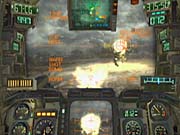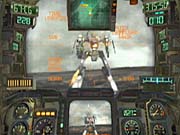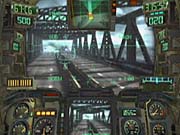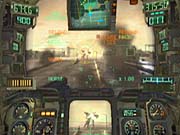In case the $199 price tag didn't clue you in, let's be blunt: Steel Battalion isn't for everyone. What started as a back-burner side project at Capcom has become one of the most ambitious and atmospheric console games ever released. The latest in a seemingly endless flood of mech games for the Xbox, Steel Battalion certainly puts on a fantastic show. Unfortunately, Steel Battalion's gameplay falls short when compared with its flashy presentation, and the result is an amazing showpiece but a less-than-stellar game.

Steel Battalion has a futuristic military theme. It's the year 2080, and the premier land-based military vehicle is the vertical tank, or VT. VTs are gigantic two-legged mechs, 10 stories high and armed with a variety of weapons. You'll pilot a VT in a mission-based campaign that has you storming beaches, stomping into cities, and generally blowing up anything that gets in your way. You'll pilot your mech using the large controller that comes with the game--Steel Battalion does not support for the standard Xbox controller in any way. Instead, the proprietary Steel Battalion control panel consists of a two-piece unit that has two joysticks, a throttle, one analog thumb pad, a radio dial, some switches, more than 30 buttons (that light up), and three foot pedals.
As you might expect, getting used to the controller is something that will take a fair amount of time. The left stick handles steering, while the right stick is used to aim your weapons. An analog pad on the left stick rotates your viewpoint around, letting you move in one direction while looking or aiming in another. A transmission lever on the left side of the panel lets you put your VT in reverse, neutral, and five forward gears. Triggers and buttons on the aiming stick are used to lock on to targets and fire your primary and secondary weapons. A cluster of buttons on the center console is used to rotate through your weapons and reload them when necessary. The radio dial is used to change communication frequencies, putting you in contact with different people on the battlefield. You'll also be able to activate a manipulator arm, which can be used to pick up tanks, hit switches, and so on.
It only gets more esoteric from there, including buttons to extinguish fires, wash your viewscreen, drop empty fuel tanks, override your VT's built-in safety limits, change your radar view, enable night vision, and change the color of your HUD. The pedals control your throttle, your brake, and your dodge ability. Then there's the all-important eject button, which is covered by a flip-up plastic cover. The controller definitely looks fit for a walking tank. However, some portions of it, especially the shifter, feel a little weak, like they might break off in your hand at any second. Considering how much the game and controller cost, it's too bad the construction of the piece isn't a little sturdier. And while there's a ton of buttons and options, so many of them are secondary and redundant that the game really could have been done on a regular Xbox controller--yet that would not only take away the game's most unique aspect, but also put an even greater focus on the deficiencies found in the gameplay.
Steel Battalion is a single-player-only, mission-based game. You'll start out each mission with a text-based briefing and a loadout process that lets you select a VT and outfit it with weapons. Once you're in your VT, you'll have to go through a start-up process. This consists of a series of button presses. One closes the cockpit, one starts the ignition. Then you must flip five switches and hit the start button when all five power bars have crossed a certain threshold. The start-up process is pretty impressive, and it does a lot for the game's atmospheric feel, though doing the exact same thing at the start of every mission causes the whole process to lose its charm after some time. Once you've started up, you can shift into gear and get moving. Most of the game's missions are pretty straightforward offensives--with only a couple of exceptions, you'll merely have to wipe out most of your enemies to advance to the next mission. The campaign is broken into two halves, and the second half is basically a remixed, harder version of the first 10 missions with a few new levels thrown in for good measure. Even without the consideration the game's price, Steel Battalion wouldn't exactly be considered a good value.

Steel Battalion starts out with two difficulty settings, but you'll unlock more when you complete the game on each of the lower difficulties. Raising the difficulty makes the enemy VTs tougher to kill, and it also speeds up weapons fire. The weapons fire in the default difficulty is surprisingly easy to dodge, thanks to its incredibly sluggish speed. Enemy missiles practically crawl at you, and a simple press of the dodge pedal and a jerk on the steering stick will cause you to hop sideways, dodging just about anything headed your way. Even when you're up against a cluster of enemy VTs, the gameplay boils down to unloading your missiles in the enemy's direction and hopping sideways whenever you see anything headed your way. You can put a slew of different weapons on your tank, including railguns, lock-on missile launchers, and light or heavy machine guns. You can also bolt on a plasma torch that can be used for melee attacks. Missiles can be locked on to enemy VTs with the touch of a button, though each missile has an effective range that must be respected. If you fire at an enemy that is 200 meters away with a missile rated for 1,000 meters or so, the missile won't arm in time. It will explode on the surface of the enemy VT, but won't actually do any damage.
Steel Battalion is as hard-core as console gaming gets. The game is a mech sim that recalls the feel of the location-based BattleTech mech combat simulators. The controller is gigantic and intentionally cumbersome. The game itself is deliberately punishing, too. When you begin play, you'll first create and name a pilot. As you progress, that pilot will earn credits that can be used to buy new VTs or the ability to resupply in the field. Should that pilot die because you failed to eject from an exploding mech before it went critical, or should you lose so many mechs that you don't have enough credits to purchase another one, the game ends--and erases your pilot's save data. Game over, big time.

Actually, considering you could merely back up your pilot to a memory card to circumvent the finality of death, this seems more like an inconvenience than something that adds to the game's realistic atmosphere. Also filed under the needless-realism heading is the game's music, which only plays if you spend 1,000 credits on a boom box. The music even sounds like it's coming out of a small, tinny portable radio speaker while you're listening to it. Most players who are willing to shell out $199 for a game with only around 10 unique missions will probably enjoy the extremes that the game goes to, but at times it almost feels like portions of the game were designed specifically to annoy. Once you've become comfortable with the game's control, though, Steel Battalion isn't very difficult at all, so losing a save or running out of credits becomes a rarity.
As much as the controller and gameplay design helps create a specific atmosphere, the game's graphics are what really stands out here. While the models themselves aren't very impressive on their own, Steel Battalion makes excellent use of filters, shaders, and plenty of other visual trickery that makes just about everything in Steel Battalion look absolutely amazing. The landscapes look like war-torn battlefields, and everything just has a gritty, realistic wartime look to it that really puts you in the thick of the fight. From the look of enemy VTs as they collapse and explode to the dirt that kicks up everywhere when you turn too fast and send your mech falling to the turf, Steel Battalion is a breathtaking visual experience.
However, it isn't without its shortcomings, which really stand out due to the great look of the rest of the game. You'll notice quite a bit of pop-up in some areas, specifically relating to tall buildings in city-based levels. It sticks out like a sore thumb when compared with the rest of the game. Also, the view window in the game is incredibly small. The viewscreen is surrounded by the rest of your cockpit, including lots of gauges, meters, and counters for your remaining ammo. Some alternate camera angles or the ability to view the game without the cockpit surrounding the view would have really been nice, though that probably would have made the game a bit less immersive. But the one thing that really hurts the presentation are the awful cutscenes and mission briefings. You would expect to see brilliantly produced video packages for each mission, detailing exactly what you need to do. But the cutscenes consist of static images of characters that make Steel Battalion look like some sort of warped, militaristic dating sim. The mission briefings make use of lightly animated maps, but they mostly consist of a picture of some sort of military commander and some relevant text.

Nevertheless, the best thing Steel Battalion has going for it is its incredible presentation, and the game's sound effects play a large role in it. The game sounds fine through standard TV speakers, but it also makes great use of the Xbox's built-in Dolby Digital support. Little things like closing the cockpit come out of all five speakers, making it truly feel like you're being surrounded by your VT's cockpit. The in-game sound is also quite good, though other games, like MechAssault, have had more impressive explosion sound effects. For a game that is clearly designed to push console gaming to the limit, again, you'd think that Capcom would have sprung for some more voice acting to go in the mission briefings, but these are text-only, complete with a couple of grammatical errors.
So does Steel Battalion really need to be played with that gigantic controller? No, since most of the nonessential functions could have been mapped to secondary menus and crammed onto the standard Xbox pad. But that's missing the point entirely. The game, with its simple "dodge then shoot" gameplay, isn't really worth playing in its own right. But when taken as a complete package, Steel Battalion is an impressive, one-of-a-kind product. With a $200 price tag and an occasionally punishing approach, Steel Battalion was clearly designed to scare off all but the most hard-core game players. If you're willing to put up with this sort of game design, you'll find a short, fairly simplistic game that is backed up by one of the most impressive presentations ever seen on a home console. If that sounds like something you'd want to own, then don't hesitate to pick up one of the huge Steel Battalion boxes as soon as possible. It's one of those unique packages that you can't find anywhere else. But people looking for exciting, deep gameplay will likely get bored with Steel Battalion rather quickly, and would definitely be better served elsewhere.